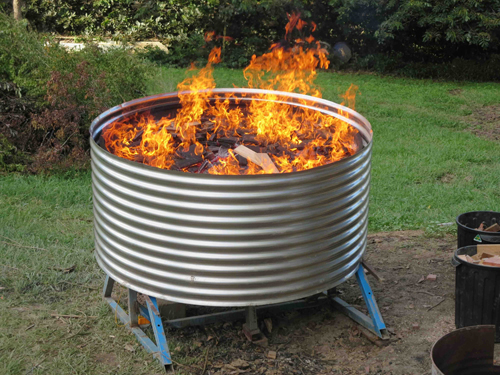Kon-Tiki Kiln: Difference between revisions
mNo edit summary |
mNo edit summary |
||
| Line 5: | Line 5: | ||
Ithaka Institut says: ''While most of the biochar produced during the last 5000 years was produced with open fire, modern pyrolysis suppresses the fire. The separation of the carbonisation and the flaming of the pyrolysis gases make pyrolysis technology prone to failure and expensive which is one of the reasons why the biochar technology did not have yet it's breakthrough. The Kon-Tiki flame curtain kiln re-connects biochar making to the ancient wisdom and craft of fire making and combines it with smart design based on modern thermodynamics to produce high quality char with low emissions.'' | Ithaka Institut says: ''While most of the biochar produced during the last 5000 years was produced with open fire, modern pyrolysis suppresses the fire. The separation of the carbonisation and the flaming of the pyrolysis gases make pyrolysis technology prone to failure and expensive which is one of the reasons why the biochar technology did not have yet it's breakthrough. The Kon-Tiki flame curtain kiln re-connects biochar making to the ancient wisdom and craft of fire making and combines it with smart design based on modern thermodynamics to produce high quality char with low emissions.'' | ||
My (Rasmus) opinion: these types of open-burn kilns | My (Rasmus) opinion: these types of open-burn kilns appear to have some advantages over those "barrel-in-a-barrel" retorts that were advocated in the past. This does away with a metal barrier (costly, labor-intensive to make, gets corroded). | ||
*[https://www.biochar-journal.org/en/ct/39 "Kon-Tiki - the democratization of biochar production" (The Biochar Jourrnal)] | *[https://www.biochar-journal.org/en/ct/39 "Kon-Tiki - the democratization of biochar production" (The Biochar Jourrnal)] (read this! - internal copy [http://opensourceecology.org/wiki/File:1437139451142.pdf here]) | ||
*[https://youtu.be/-AebWIpGu4I Youtube: "Kon-Tiki: Biochar making in open burn deep cone kiln"] | *[https://youtu.be/-AebWIpGu4I Youtube: "Kon-Tiki: Biochar making in open burn deep cone kiln"] | ||
*[http://www.ithaka-institut.org/en/ct/101 More videos from Ithaka Institut] | *[http://www.ithaka-institut.org/en/ct/101 More videos from Ithaka Institut] | ||
*[http://www.ithaka-institut.org/ithaka/media/doc/kon-tiki-presentation.pdf Ithaka Inst.: "Download the presentation of the Kon-Tiki technology" (.pdf)] | *[http://www.ithaka-institut.org/ithaka/media/doc/kon-tiki-presentation.pdf Ithaka Inst.: "Download the presentation of the Kon-Tiki technology" (.pdf)] | ||
Revision as of 19:50, 29 February 2016
Excellent open source pyrolysis kiln from Switzerland for biochar production with a very clean burn. Some implements are already available and everything is open source.
Ithaka Institut says: While most of the biochar produced during the last 5000 years was produced with open fire, modern pyrolysis suppresses the fire. The separation of the carbonisation and the flaming of the pyrolysis gases make pyrolysis technology prone to failure and expensive which is one of the reasons why the biochar technology did not have yet it's breakthrough. The Kon-Tiki flame curtain kiln re-connects biochar making to the ancient wisdom and craft of fire making and combines it with smart design based on modern thermodynamics to produce high quality char with low emissions.
My (Rasmus) opinion: these types of open-burn kilns appear to have some advantages over those "barrel-in-a-barrel" retorts that were advocated in the past. This does away with a metal barrier (costly, labor-intensive to make, gets corroded).
